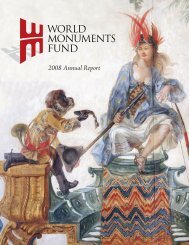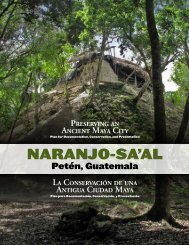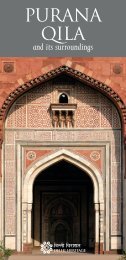Summary of the Proceedings and Papers Presented at - World ...
Summary of the Proceedings and Papers Presented at - World ...
Summary of the Proceedings and Papers Presented at - World ...
You also want an ePaper? Increase the reach of your titles
YUMPU automatically turns print PDFs into web optimized ePapers that Google loves.
This exhibition, possible <strong>at</strong> a time when <strong>the</strong> excav<strong>at</strong>ions<br />
were not yet under siege by mass tourism, remained open<br />
only for a few years due to <strong>the</strong> fragility <strong>of</strong> <strong>the</strong> finds.<br />
The damage caused by changes in temper<strong>at</strong>ure <strong>and</strong> <strong>at</strong>mospheric<br />
agents, <strong>the</strong> constant need to maintain <strong>the</strong> display<br />
cases, <strong>the</strong> dangers <strong>of</strong> <strong>the</strong>ft, due in part to <strong>the</strong> development<br />
<strong>of</strong> tourism, gradually led to <strong>the</strong> objects being placed in storage,<br />
<strong>and</strong> <strong>the</strong> dismantling <strong>of</strong> <strong>the</strong> display cases.<br />
Today only a few <strong>of</strong> <strong>the</strong>se remain, containing architectural<br />
fragments <strong>and</strong> plaster work, evidence <strong>of</strong> an <strong>at</strong>tempt to cre<strong>at</strong>e<br />
an open-air museum which we might consider recre<strong>at</strong>ing<br />
using copies <strong>and</strong> multimedia displays.<br />
Recording <strong>the</strong> wall structures<br />
The next step in our study <strong>of</strong> <strong>the</strong> houses in <strong>the</strong> Insula Orientalis<br />
I was an <strong>at</strong>tempt to outline <strong>the</strong> settlement history <strong>of</strong><br />
<strong>the</strong> insula through an analytical recording <strong>of</strong> wall structures.<br />
After <strong>the</strong>ir discovery, <strong>the</strong>se houses were never studied in<br />
full, but were merely published in descriptive form in Maiuri’s<br />
fundamental 1958 volume on <strong>the</strong> new excav<strong>at</strong>ions.<br />
Our study <strong>of</strong> wall structures employed <strong>the</strong> system based<br />
on recording str<strong>at</strong>igraphic wall units, developed by <strong>the</strong> Istituto<br />
Centrale per il C<strong>at</strong>alogo e la Documentazione <strong>of</strong> <strong>the</strong><br />
Ministero per i Beni e le Attività Culturali. This system was<br />
modified <strong>and</strong> refined, <strong>and</strong> subsequently tested on Insula VI<br />
<strong>at</strong> Pompeii, thus improving <strong>the</strong> links between <strong>the</strong> various elements<br />
in both a hierarchical <strong>and</strong> horizontal sense. For <strong>the</strong><br />
three houses in <strong>the</strong> Insula Orientalis I we thus compiled inform<strong>at</strong>ion<br />
sheets on each room, wall, aperture, str<strong>at</strong>igraphic<br />
wall unit <strong>and</strong> str<strong>at</strong>igraphic decor<strong>at</strong>ion unit. These l<strong>at</strong>er came<br />
to form part <strong>of</strong> inform<strong>at</strong>ion sheets for <strong>the</strong> domus <strong>and</strong> insula.<br />
Individual fe<strong>at</strong>ures were <strong>the</strong>n shown on high definition digital<br />
photographs; <strong>the</strong>se, toge<strong>the</strong>r with <strong>the</strong> inform<strong>at</strong>ion sheets,<br />
will form part <strong>of</strong> a d<strong>at</strong>abase specifically developed for <strong>the</strong><br />
project. The d<strong>at</strong>abase will also contain inform<strong>at</strong>ion sheets<br />
compiled by conserv<strong>at</strong>ors, <strong>and</strong> all <strong>the</strong> inform<strong>at</strong>ion <strong>and</strong> images<br />
found during our archival research.<br />
The study <strong>of</strong> wall structures has allowed us to identify<br />
<strong>and</strong> analyse <strong>the</strong> individual elements <strong>of</strong> each wall, cre<strong>at</strong>ing<br />
a common basis for all <strong>the</strong> specialists, including architects,<br />
restorers, <strong>and</strong> archaeologists, who will carry out restor<strong>at</strong>ion<br />
work. These inform<strong>at</strong>ion sheets allow each specialist<br />
Herculaneum – The House <strong>of</strong> <strong>the</strong> Gem (Ins. Or. I.1), west wall <strong>of</strong><br />
room 14; an example <strong>of</strong> <strong>the</strong> c<strong>at</strong>alogue <strong>of</strong> wall structures developed<br />
as part <strong>of</strong> <strong>the</strong> work <strong>of</strong> <strong>the</strong> Herculaneum Conserv<strong>at</strong>ion Project.<br />
to instantly <strong>and</strong> unequivocally identify <strong>and</strong> define <strong>the</strong> wall<br />
str<strong>at</strong>a. At <strong>the</strong> same time, <strong>the</strong>y ensure th<strong>at</strong> during conserv<strong>at</strong>ion<br />
work, fe<strong>at</strong>ures such as traces <strong>of</strong> blocked-up doors <strong>and</strong><br />
windows, scaffolding holes <strong>and</strong> superimposed layers <strong>of</strong> brick<br />
or plasterwork, which may be important for <strong>the</strong> interpret<strong>at</strong>ion<br />
<strong>of</strong> <strong>the</strong> monumentís history, are not lost.<br />
The analysis <strong>of</strong> wall structures has also been <strong>of</strong> fundamental<br />
importance in outlining a preliminary history <strong>of</strong> <strong>the</strong><br />
transform<strong>at</strong>ions th<strong>at</strong> <strong>the</strong> buildings in this insula have undergone.<br />
A reading <strong>of</strong> <strong>the</strong> elev<strong>at</strong>ions has already allowed us to<br />
reconstruct various different phases, characterized by <strong>the</strong><br />
rebuilding, enlargement, <strong>and</strong> unific<strong>at</strong>ion <strong>of</strong> <strong>the</strong> residential<br />
complexes, which appear to be centred on <strong>the</strong> House <strong>of</strong><br />
<strong>the</strong> Telephus Relief, <strong>the</strong> most significant element in all <strong>the</strong><br />
phases <strong>of</strong> <strong>the</strong> insula’s history.<br />
This analytical interpret<strong>at</strong>ion has opened up numerous<br />
new lines <strong>of</strong> research which will be pursued in depth with a<br />
series <strong>of</strong> archaeological test pits. It is hoped th<strong>at</strong> <strong>the</strong>se will<br />
confirm our interpret<strong>at</strong>ion <strong>of</strong> <strong>the</strong> elev<strong>at</strong>ions, <strong>and</strong> provide new<br />
d<strong>at</strong>a on <strong>the</strong> most ancient phases <strong>of</strong> inhabit<strong>at</strong>ion in this area.<br />
12 A. MAIURI, Ercolano, I nuovi scavi (1927-1958), Roma 1958, pp. 336-360.<br />
13 The system developed by Dott.ssa Maria Paola Guidobaldi <strong>and</strong> Pr<strong>of</strong>.<br />
Fabrizio Pes<strong>and</strong>o for <strong>the</strong> study <strong>of</strong> elev<strong>at</strong>ions <strong>at</strong> Pompeii is currently<br />
being used for research in <strong>the</strong> Regio VI <strong>at</strong> Pompeii by <strong>the</strong> universities <strong>of</strong><br />
Perugia, Napoli “Orientale”, Trieste <strong>and</strong> Venezia. See M.P. Guidobaldi-F.<br />
Pes<strong>and</strong>o, Variazioni di proprietà nell’insula VI,9: indagine nella Casa del<br />
Centauro (VI, 9, 3-5 e 10-12), in Rstpomp. IX, 1998, pp. 217-224.
















